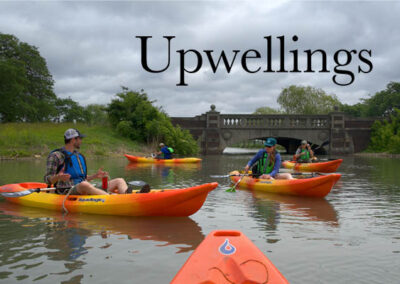
Val Gagnon welcomes attendees. Photo: MISG
“It is refreshing to be surrounded by so many knowledge holders and to watch the sparks of curiosity and understanding glow.”
That was one participant’s response after attending the 2022 Indigenous Knowledges Symposium at Michigan Technological University. Held on October 24-25, 2022, the event focused on stewardship and governance of the natural world in a way that includes traditional ecological knowledge alongside scientific planning and management.
The symposium was part of a Michigan Sea Grant-funded project led by Valoree Gagnon, assistant professor at the MTU College of Forest Resources and Environmental Science and the director of university-Indigenous community partnerships at the MTU Great Lakes Research Center. She and her team have been working since 2020 with the Keweenaw Bay Indian Community (KBIC) in northern Michigan and the Great Lakes Indian Fish and Wildlife Commission (GLIFWC) to create an Indigenous knowledge guidance document. The document aims to convey the principles that frame KBIC’s relationships with the land they inhabit and steward. Learn more about Anishinaabe-gikendaasowin and Gagnon’s project, and get a sneak peek at the guiding principles.
Working on the guidance document helped Val Gagnon, her research team, and KBIC and GLIFWC partners shape the format of the Indigenous Knowledges Symposium they hosted on MTU’s campus in Houghton. The two-day symposium brought together Indigenous teachers, government agency staff, researchers, students, educators, and community members to listen, learn, and build relationships.
Kristin Arola, an associate professor and writer at Michigan State University, delivered the first day’s plenary talk. She spoke about the ways Indigenous knowledges can interrupt cycles of systemic injustice against people and the land. The second day’s plenary speaker, Margaret Noodin, is a poet and professor at the University of Wisconsin-Madison. She presented about the links among Anishinaabe languages, worldviews, and stewardship practices.
Indigenous teachers led workshops about land-based frameworks for understanding climate change, relationships among humans and wildlife, respect for sacred plants like tobacco, and more. Participants learned songs of healing, made tobacco pouches, spoke with community elders, unpacked the implications of land acknowledgements, and watched a documentary about cultural practices related to fire.

Interviews with KBIC, GLIFWC, and partners yielded artful word clouds. Photo: MISG
On the second day, attendees had the chance to exchange gifts that connected back to their own homes, passions, and cultures. Participants built new relationships as they swapped handmade jewelry, artwork, and cookies for books or a jar of kimchi or honey.
More than 70 of the attendees participated in a follow-up survey about the Symposium. Nearly half self-identified as natural resource or environmental professionals, with strong representation from college and university students and educators. Half also said that they had attended the event out of personal interest, within or outside their professional capacity. Feedback was overwhelmingly positive, with many stating that they hope similar events are scheduled regularly. Seventy percent expressed an interest in learning more about Indigenous knowledges pertaining to climate change, adaptations, and resiliency. Many were also interested in learning about Indigenous languages, stewardship practices, and relations to wildlife and plants.
As one participant responded, “KBIC is my tribe, and climate change happens right in front of us. This gave me the opportunity to learn more about what effects are happening and how we can work together to make change.”
“I am Native American and thoroughly enjoyed all the presentations I went to,” wrote another attendee. “I love hearing the language spoken.”
The symposium organizers intentionally built in plenty of time for introductions, transitions, and conversation. Several attendees applauded this choice, with one saying, “There was a different tempo and pace from other conferences, and it set a tone.”
Cindy Hudson attended the symposium in her role as communications manager for Michigan Sea Grant Extension. She reflected:

Local news covered the event, including an interview with Val Gagnon. Photo: MISG
“One lesson I experienced was the value of slowing down the agenda to allow more time for relationships to develop. This symposium deliberately created time for introductions and learning about each participant, and more time for conversations to develop among attendees. Michigan Sea Grant Extension Educator Lauren Jescovitch also attended the symposium. She recently coordinated a conference and decided to build extra time into the agenda for introductions, breaks, and meals. I could tell that it made a difference and encouraged relationship-building — a valuable addition to the agenda.”
In addition to modeling a different pace, the symposium provided plenty of potential for growth. Using what they learned, participants listed some activities they plan to add to their lives, such as deepening the relationships they forged at the event, developing lessons for K-12 classrooms, getting more involved with KBIC, learning Anishinaabe language, and reconnecting with their own cultures.
While Gagnon’s current project only planned for one symposium, survey responses expressed a wish for more events like it, both in Northern Michigan and in other Indigenous communities. In the meantime, keep up with Gagnon’s work at the MTU Great Lakes Research Center, learn about KBIC and GLIFWC, and watch for the project’s guidance document to be released later in 2023.


